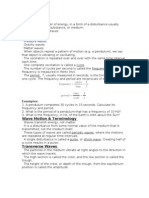1 - Electromagnetic Spectrum
1 - Electromagnetic Spectrum
Uploaded by
binyang lalaCopyright:
Available Formats
1 - Electromagnetic Spectrum
1 - Electromagnetic Spectrum
Uploaded by
binyang lalaOriginal Description:
Original Title
Copyright
Available Formats
Share this document
Did you find this document useful?
Is this content inappropriate?
Copyright:
Available Formats
1 - Electromagnetic Spectrum
1 - Electromagnetic Spectrum
Uploaded by
binyang lalaCopyright:
Available Formats
Electromagnetic Spectrum
Why do some things have colors? What makes color?
Why do fast food restaurants use red lights to keep food warm? Why
don’t they use green or blue light?
Why do X-rays pass through the body and let us see through the body?
What has the radio to do with radiation?
What are the night vision devices that the army uses in night time
fighting?
To find the answers to these questions we have to examine the
electromagnetic spectrum.
FASTER THAN A SPEEDING BULLET
MORE POWERFUL THAN A LOCOMOTIVE
These words were used to introduce a fictional superhero named
Superman. These same words can be used to help describe
Electromagnetic Radiation.
Electromagnetic Radiation is like a two member team racing together at
incredible speeds across the vast regions of space or flying from the
clutches of a tiny atom. They travel together in packages called photons.
Moving along as a wave with frequency and wavelength they travel at
the velocity of 186,000 miles per second (300,000,000 meters per second)
in a vacuum. The photons are so tiny they cannot be seen even with
powerful microscopes. If the photon encounters any charged particles
along its journey it pushes and pulls them at the same frequency that
the wave had when it started. The waves can circle the earth more than
seven times in one second!
If the waves are arranged in order of their wavelength and frequency
the waves form the Electromagnetic Spectrum. They are described as
electromagnetic because they are both electric and magnetic in nature.
The Electromagnetic Spectrum consists of radio waves, microwaves (a
type of radio wave), infrared rays, visible light, ultraviolet rays, X-rays,
and gamma rays.
Waves with the longest wavelengths have the lowest frequencies. Waves
with the shortest wavelengths have the highest frequencies.
Electromagnetic waves in the spectrum range from very long
wavelength, low frequency radio waves to very short wavelength high
frequency gamma rays. Visible light is only a very small portion of the
spectrum that you can detect with your eyes. The rest of the
electromagnetic spectrum is invisible.
A wave is a rhythmic disturbance which travels through space or
matter. Consider a water wave. The place where the water surface is
highest is the crest. Where the water surface is lowest is the trough. The
distance between crests or troughs is called its wavelength. The height of
the wave above the normal water surface (nodal line) is the amplitude of
the wave. If you count the number of crests that pass a certain point per
second that quantity is the frequency of the wave. Suppose 14 crests
pass a point in 10 seconds. The frequency is 14 crests divided by 10 or
1.4 crests per second. The modern metric system, known as SI, contains
all the uints scientists have agreed to use for all their measurements.
The letters SI come from the French name for international system. The
SI unit for the number per second is the hertz (Hz). So the frequency
here would be 1.4 Hz.
The frequency of a wave is related to its wavelength. The more crests
that pass a point per second, the closer together they must be. Thus the
higher the frequency the shorter the wavelength. Waves with lower
frequencies have longer wavelengths.
Electromagnetic waves are transverse waves. The moving photons of
energy generate electric and magnetic fields. Thus an electromagnetic
wave is both electric and magnetic in nature. The electric and magnetic
fields are at right angles to each other and to the direction of wave
energy.
In a compressed wave, particles move back and forth along the
direction of a wave motion.
RADIO WAVES, MICROWAVES, INFRARED, VISIBLE LIGHT,
ULTRAVIOLET, X-RAYS, GAMMA RAYS
How can waves be so different from each other and yet be the same?
In spite of their varying differences they are all electromagnetic
radiation. All can be described as streams of photons traveling at the
speed of light. Each photon contains a bundle of energy. What is
different is the amount of energy each carries.
TYPES OF RADIATION IN THE ELECTROMAGNETIC
SPECTRUM
RADIO WAVE: Radio waves have the longest wavelength. Their
wavelengths can be as long as a football field or as short as the football
lying on the field. These waves are part of the electromagnetic spectrum
and travel at the speed of light. We are very familiar with two kinds of
radio waves called AM waves and FM waves. AM waves are sine waves.
Both AM radio stations and the picture part of a TV signal use
amplitude modulation (AM) to encode information. FM radio stations
and hundreds of other wireless technologies (including the sound
portion of a TV signal, cordless phones, cell phones, etc.) use frequency
modulation (FM). Antennas broadcast waves that travel through the
air. Other antennas pick up the signals and produce an electric current
which is carried to a receiver and amplified. Antennas come in all
shapes and sizes, depending on the frequency the antenna is trying to
receive.
MICROWAVES: Microwaves are very short radio waves. They are
between ordinary radio waves and infrared rays. They are used not only
for communication but also for heating our food. Since microwaves can
pass through rain, smoke, and fog they are good for transmitting
information. Shorter microwaves are used in remote sensing devices
such as Doppler radar. Those microwaves are just a few inches long.
INFRARED: Infrared lies between visible light and microwaves on the
electromagnetic spectrum. Their wavelengths vary from the size of a pin
head to the size of cells. These are thermal waves and are used to dry or
heat things. Cooked foods in restaurants are kept warm by infrared
lamps. Shorter infrared waves are used by your TV’s remote. Any
object which has a temperature radiates in the infrared. Even ice cubes
emit infrared. Special cameras and film detect differences in
temperatures and assign different brightness’s or false colors to them.
This provides a picture that our eyes can interpret.
VISIBLE LIGHT: Visible light lies between infrared and ultraviolet. It
is the only part of the electromagnetic spectrum that we can see. Light
wave frequencies are between 430 trillion hertz and 760 trillion hertz.
While light actually consists of many different colors, each color has its
own special frequency. Red has the lowest at 430 trillion hertz. It also
carries the lowest energy. Violet has the highest frequency at 760 trillion
hertz and carries the highest energy.
ULTRAVIOLET: Found just above visible light, ultraviolet radiation is
present in sunlight. When sunlight strikes your body the ultraviolet
radiation produces vitamin D in your skin. Vitamin D is needed for
healthy bones and teeth. Ultraviolet radiation kills germs. For this
reason hospitals often use ultraviolet lamps to kill germs in operating
rooms. Ultraviolet radiation is invisible and its wavelength is shorter
than visible light. It can be detected with a fluorescent material which
will glow and give off light when struck by ultraviolet radiation.
Overexposure to ultraviolet can be harmful and can cause skin cancer.
X-rays: Discovered in 1895 by German physicist W. K. Roentgen, X-
rays lie just above ultraviolet on the Electromagnetic Spectrum. They
have high energy and a short wavelength. X-rays can pass through all
matter however all substances absorb them to some degree. The amount
absorbed depends upon the density of the material. For this reason they
are useful in looking at bones and teeth.
Gamma Radiation: Gamma rays are energy waves of short wavelengths
and high frequency. They are photons of energy that travel at the speed
of light. They are more penetrating than either alpha or beta rays. It
takes a dense material such as lead or concrete to stop gamma rays.
They are used to treat cancer.
You might also like
- 4227-Optics and Sound Assignment QuestionsDocument11 pages4227-Optics and Sound Assignment Questionsamie0% (2)
- (CIE Teacher Support) A2 Level - Common Questions On Medical Physics & TelecommunicationsDocument8 pages(CIE Teacher Support) A2 Level - Common Questions On Medical Physics & TelecommunicationsjohnNo ratings yet
- SSLC Wave Motion Kerala English MediumDocument6 pagesSSLC Wave Motion Kerala English MediumAKHILSTNo ratings yet
- Resonance and Speed of Sound Formal Report - PhysicsDocument2 pagesResonance and Speed of Sound Formal Report - PhysicsPatricia Isabel TayagNo ratings yet
- Physical AppearancesDocument27 pagesPhysical AppearancesTarik David BlountNo ratings yet
- Electric Fields in Material SpaceDocument144 pagesElectric Fields in Material Spacefranklinreypacquiao100% (1)
- The Electromagnetic Spectrum 3Document7 pagesThe Electromagnetic Spectrum 3Nur-shima SakilinNo ratings yet
- CHP 22 - Electromagnetic WavesDocument14 pagesCHP 22 - Electromagnetic WavesFrankNo ratings yet
- Speciallabreport1 EmorrisDocument11 pagesSpeciallabreport1 Emorrisapi-666972723No ratings yet
- Experiment #17: Refraction: BjectivesDocument4 pagesExperiment #17: Refraction: BjectivesAref DahabrahNo ratings yet
- Unit 16 Electromagnetic WavesDocument10 pagesUnit 16 Electromagnetic Wavesadfh100% (1)
- Waves - 3 Sound WavesDocument3 pagesWaves - 3 Sound WavesullasagwNo ratings yet
- Problem Sheet of Relativity-Summer 2011-12Document2 pagesProblem Sheet of Relativity-Summer 2011-12Shahriar RahmanNo ratings yet
- Ec2403 RF and Microwave EngineeringDocument2 pagesEc2403 RF and Microwave EngineeringsophialeebanNo ratings yet
- Antennas and Wave Propagation - U5Document20 pagesAntennas and Wave Propagation - U5kitt immadiNo ratings yet
- Fundamentals of Ultrasonic Imaging and Flaw Detection - NI-Tutorial-3368-EnDocument5 pagesFundamentals of Ultrasonic Imaging and Flaw Detection - NI-Tutorial-3368-Enafsajghfd1No ratings yet
- TB Chapter36Document14 pagesTB Chapter36qvrlenarasegtNo ratings yet
- Ultrasonics PhysicsDocument14 pagesUltrasonics PhysicsafifezzatNo ratings yet
- Detailed Notes - Section 03 Waves - AQA Physics A-Level PDFDocument12 pagesDetailed Notes - Section 03 Waves - AQA Physics A-Level PDFAdamu BukariNo ratings yet
- Electromagnetic Induction - 0Document14 pagesElectromagnetic Induction - 0Micah PañaNo ratings yet
- Chapter Test A: Atomic PhysicsDocument6 pagesChapter Test A: Atomic PhysicsJun MitsuhashiNo ratings yet
- Pitch and FrequencyDocument14 pagesPitch and FrequencyHelmiyanto IsmoyoNo ratings yet
- Resonance and Speed of SoundDocument2 pagesResonance and Speed of SoundLove1726No ratings yet
- Sound - ICSE Solutions For Physics: Short AnswersDocument34 pagesSound - ICSE Solutions For Physics: Short AnswersPooja SharmaNo ratings yet
- Electromagnetic FieldsDocument4 pagesElectromagnetic FieldsKrishna Reddy SvvsNo ratings yet
- Unit 1 - Step 2Document3 pagesUnit 1 - Step 2Jose Daniel Ochoa MoyaNo ratings yet
- Unit-V - Acoustics and UltrasonicsDocument39 pagesUnit-V - Acoustics and Ultrasonicsmwita mwitaNo ratings yet
- Unit-1 and 2 OpticalDocument278 pagesUnit-1 and 2 OpticalGuru VelmathiNo ratings yet
- IAGA Guide For Geomagnetic Observatories.Document238 pagesIAGA Guide For Geomagnetic Observatories.sarveshchandraNo ratings yet
- To College DESIGN OF TAPER SLOT ARRAY FOR ULTRA WIDE Review 1.1Document24 pagesTo College DESIGN OF TAPER SLOT ARRAY FOR ULTRA WIDE Review 1.1Subburam SrinivasanNo ratings yet
- Telcom Tutorial ND IiiDocument33 pagesTelcom Tutorial ND IiiThompson Micheal100% (1)
- The Electromagnetic Spectrum: Year 11 PhysicsDocument18 pagesThe Electromagnetic Spectrum: Year 11 PhysicsStephen HillNo ratings yet
- Basic Wave Theory Review: Graham Warren Bureau of Meteorology AustraliaDocument33 pagesBasic Wave Theory Review: Graham Warren Bureau of Meteorology Australiarenda tiyarsoNo ratings yet
- Experiment 4 Vibrating StringsDocument7 pagesExperiment 4 Vibrating StringsDonnaliza Delos Reyes0% (1)
- Question Bank (ECE)Document7 pagesQuestion Bank (ECE)Manav JainNo ratings yet
- Topic 4.2 - Traveling WavesDocument47 pagesTopic 4.2 - Traveling WavesPaul AmezquitaNo ratings yet
- Notes On Interference N Diffraction of WavesDocument10 pagesNotes On Interference N Diffraction of WavesHubbak KhanNo ratings yet
- Poisson and Laplace EquationDocument7 pagesPoisson and Laplace EquationLadla Malik100% (1)
- Classroom Assignment 5 With AnswersDocument2 pagesClassroom Assignment 5 With AnswersBishoy EmileNo ratings yet
- WavesDocument19 pagesWavesNAVEED AHMEDNo ratings yet
- RF Power DetectorsDocument43 pagesRF Power Detectorsromilg_1100% (1)
- ch5 Phy PDFDocument39 pagesch5 Phy PDFStar Packs Print SolutionNo ratings yet
- Antenna Part B QuestionsDocument2 pagesAntenna Part B QuestionsArshad MohammedNo ratings yet
- E by M Thomson Method PDFDocument21 pagesE by M Thomson Method PDFJAY BHAGATNo ratings yet
- Physics Form 5: WavesDocument47 pagesPhysics Form 5: WavesRamliRem100% (1)
- Perovskite - A Structure of Great Interest To Geophysics and Materials ScienceDocument148 pagesPerovskite - A Structure of Great Interest To Geophysics and Materials ScienceNguyen TrangNo ratings yet
- GSN Raju Electromagnetic Field Theory 35 PDFDocument4 pagesGSN Raju Electromagnetic Field Theory 35 PDFSuryaCharanPaidipalli100% (1)
- Lec30 Plane Wave at Dielectric InterfaceDocument35 pagesLec30 Plane Wave at Dielectric InterfaceArchana TripathiNo ratings yet
- Unit 5 - Antenna & Wave Propagation - WWW - Rgpvnotes.inDocument19 pagesUnit 5 - Antenna & Wave Propagation - WWW - Rgpvnotes.inRohit kumarNo ratings yet
- PSI AP Physics 1: Sound Waves Practice ProblemsDocument16 pagesPSI AP Physics 1: Sound Waves Practice ProblemsAlexa AquinoNo ratings yet
- Mechanical Waves Lab ReportDocument3 pagesMechanical Waves Lab ReportdeanyktheuNo ratings yet
- Studies of excited nuclear states by using the γγ-coincidence techniqueDocument11 pagesStudies of excited nuclear states by using the γγ-coincidence techniqueArani ChaudhuriNo ratings yet
- Module 3Document18 pagesModule 3Bhavya ShreeNo ratings yet
- Chapter5 150508221315 Lva1 App6891 PDFDocument38 pagesChapter5 150508221315 Lva1 App6891 PDFfarouq_razzaz2574No ratings yet
- Acoustics Fundamentals: Raymund M. Lozada, PECEDocument20 pagesAcoustics Fundamentals: Raymund M. Lozada, PECEJohn Delrosario100% (2)
- A Study of Backing Layer Structure ForDocument3 pagesA Study of Backing Layer Structure ForaliNo ratings yet
- Electromagnetic WavesDocument17 pagesElectromagnetic WavesShazira Ally100% (1)
- 2NDQ Science NotesDocument38 pages2NDQ Science NotesEzekiel BayocotNo ratings yet
- G10 Science Q2 W1 Electromagnetic WavesDocument47 pagesG10 Science Q2 W1 Electromagnetic WavesnickanormacaraegNo ratings yet
- G10 Science Q2- W1-2- Electromagnetic WavesDocument48 pagesG10 Science Q2- W1-2- Electromagnetic WavesJessel GiganteNo ratings yet
- Science 10Document38 pagesScience 10Angelo LiwanagNo ratings yet
- E6C2-CWZ6C 1000P - R 2M - OMRON Industrial AutomationDocument4 pagesE6C2-CWZ6C 1000P - R 2M - OMRON Industrial AutomationmallardfirstNo ratings yet
- Course Folder of Fluid Mechanics: GeneralDocument7 pagesCourse Folder of Fluid Mechanics: GeneralShreyas GuptaNo ratings yet
- Molecular Transport Equation and General Property BalanceDocument56 pagesMolecular Transport Equation and General Property BalanceJant Erbert Garboso100% (1)
- DC Fuel Quantity Test Set DC400ADocument1 pageDC Fuel Quantity Test Set DC400AjohnnysNo ratings yet
- LESCO4Document1 pageLESCO4Dr. Tanvir ZaverNo ratings yet
- Dist BoardsDocument28 pagesDist Boardseng_waleed2008No ratings yet
- User Manual: Commax Converter Unit Ccu-204AgfDocument11 pagesUser Manual: Commax Converter Unit Ccu-204Agfnetconex clNo ratings yet
- MOS Civil EngineeringDocument19 pagesMOS Civil EngineeringSahar GulNo ratings yet
- SAES-B-005, Spacing and Diking For Atmospheric and Low-Pressure TanksDocument13 pagesSAES-B-005, Spacing and Diking For Atmospheric and Low-Pressure TanksabdNo ratings yet
- AhwinDocument69 pagesAhwinPrashant ThapaNo ratings yet
- IPG Or-01 - PTC Train Infrastructure Electrical Safety RulesDocument50 pagesIPG Or-01 - PTC Train Infrastructure Electrical Safety Rules4493464No ratings yet
- CuproBraze 34Document2 pagesCuproBraze 34Vinod SaleNo ratings yet
- Sec 1H (4HL1)Document11 pagesSec 1H (4HL1)Susilo purwanggiNo ratings yet
- UMP-19030115710664-Zulhida Rahmi-Tugas Akhir Instrumen Evaluasi 2Document17 pagesUMP-19030115710664-Zulhida Rahmi-Tugas Akhir Instrumen Evaluasi 2mikayla septiaNo ratings yet
- General Arrangement Drawing: Pump DataDocument1 pageGeneral Arrangement Drawing: Pump DataJwardNo ratings yet
- DrenadoresDocument5 pagesDrenadoresEloy Armando Rodriguez PazNo ratings yet
- Shakarganj Mills LTD - Allah Dita Hassan - 2Document44 pagesShakarganj Mills LTD - Allah Dita Hassan - 2Muhammad Asif Noor100% (1)
- 938g II en (cf8)Document24 pages938g II en (cf8)Carlos Arturo AcevedoNo ratings yet
- JRA-CDA-PL-032-REV-0 - Removal, Modification and Reinstallation of Snatch PostsDocument6 pagesJRA-CDA-PL-032-REV-0 - Removal, Modification and Reinstallation of Snatch PostsMiller DutraNo ratings yet
- Anbussa City Bus Service Enterprise HistoryDocument10 pagesAnbussa City Bus Service Enterprise HistorySeyfeAlemayehuNo ratings yet
- Physics ProjecDocument15 pagesPhysics ProjecAnonymous ytZsBOVNo ratings yet
- Ccfl-Inverter DS-1307WKDocument14 pagesCcfl-Inverter DS-1307WKsachinNo ratings yet
- E11 - Vacuum Fault Interrupter Switchgear (Approved) PDFDocument37 pagesE11 - Vacuum Fault Interrupter Switchgear (Approved) PDFBryan LlenaNo ratings yet
- Pre-Commissioning Checklist Azimuth ThrusterDocument4 pagesPre-Commissioning Checklist Azimuth ThrusterTzeh Kang LooNo ratings yet
- Differential EquationDocument21 pagesDifferential EquationChristopher Paladio100% (1)
- GATE 2014 Civil Engineering Keys & Solution (Evening Session)Document36 pagesGATE 2014 Civil Engineering Keys & Solution (Evening Session)Lokesh Kumar100% (1)
- Ysio Max ENDocument12 pagesYsio Max ENcurduroy100% (1)
- Analysis of Corrosion Products TransportDocument7 pagesAnalysis of Corrosion Products TransportAndrei DianaNo ratings yet
- SI44M 60H 80H-DeN1730-V12web DownloadedDocument4 pagesSI44M 60H 80H-DeN1730-V12web DownloadedtauraimukumbaNo ratings yet

























































































